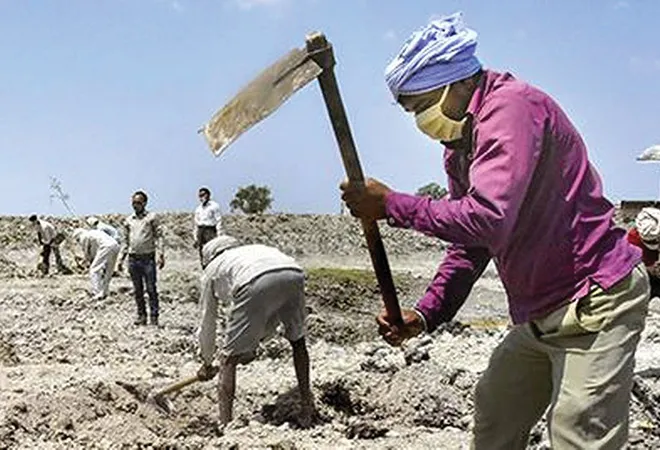-
CENTRES
Progammes & Centres
Location

Several states in India are now completing the fifth month of lockdowns and social distancing measures. Within this time, a report predicts that COVID19 pandemic will leave 130 million unemployed in India, 40 percent of those from the blue collar economy. According to the World Bank, 12 million people in India may slip below the poverty line due to pandemic-related job losses. The repercussions of the COVID-19 crisis for low-skilled migrant labourers and informal workers have been overwhelming. Due to lack of social security nets and formal benefits, these labourers have lost their jobs and travelled to their home towns without any guarantee of returning. In Maharashtra, for example, occupation of the migrant labourers that come into cities like Mumbai from drought-prone regions and migrate seasonally as labourers in brickmaking, construction, tile factories, and sugar factories, have had to reverse migrate to their rural communities, where household poverty through lack of income and remittances is said to skyrocket.
While the unemployment rate is said to have reverted to pre-COVID levels as of July, policymakers must safeguard the economy from such drastic impact from future shocks. The budgetary allocation for the Mahatma Gandhi National Rural Employment Guarantee Act (MGNREGA), a social security initiative which seeks to guarantee ‘right to work’ in the current financial year 2020-21 was INR 615 billion. On 17 May, Union Finance Minister Nirmala Sitharaman announced an allocation of an additional INR 400 billion for the scheme as a part of the INR 20,000 billion economic stimulus package announced under the government’s ''Aatmanirbhar'' (self-sufficient) campaign. This increase was in light of the mass reverse migration taking place so that these newly unemployed labourers could get employed in their hometowns. The government also increased the daily wage rate of labourers under MGNREGA from INR 182 to INR 202.
Through these measures, daily wage labourers in the villages got 84 percent more work in June than in the corresponding period last year. The number of people employed under MGNREGA in Punjab was 1.5 lakh during the financial year 2019-20, which has gone up to 2.2 lakh in the current financial year. In Chhattisgarh, according to the official records, over 24.28 lakh women secured jobs through MGNREGA during the different phases of lockdown. Are these measures sufficient as a solution to employment generation and poverty reduction in the context of the COVID crisis?
MGNREGA was launched in September 2005 under the prime ministership of Dr. Manmohan Singh. We are in the 15th year of the implementation of the MGNREGA programme operational in about 691 districts in the country. As per its preamble, MGNREGA, the world’s largest social welfare scheme, promises to provide for the enhancement of livelihood security of the households in rural areas of the country by providing at least one hundred days of guaranteed wage employment in every financial year to every household whose adult members volunteer to do unskilled manual work and for matters connected therewith or incidental thereto. The primary objectives underlying the launch of the MGNREGA programme are as follows: income and employment security, provision of employment opportunities close to place of residence, provision of minimum wages, creation of durable assets such as wells, ponds, roads etc for the welfare of the community.
The 2014 iteration of the World Development Report published by the World Bank refers to the MGNREGA as a stellar example of rural development. Studies have revealed that the MGNREGA initiative has reduced poverty and prevented many from falling into poverty. MGNREGA has created work, boosted incomes and consumption expenditure especially during the lean season. Studies have revealed an enhanced health quotient, improved food and nutrient intake as a consequence of the employment programme.
"The 2014 iteration of the World Development Report published by the World Bank refers to the MGNREGA as a stellar example of rural development. Studies have revealed that the MGNREGA initiative has reduced poverty and prevented many from falling into poverty."
As a social protection measure, the inclusivity of MGNREGA both in terms of economic and social groups has been exemplary. The poorer among the poor sections of society have been more attracted to the employment scheme. The participation of Scheduled Castes and Scheduled Tribes has also been consistently high since its launch. The design and the wage rates of the scheme encourages participation of women in a significant way. Majority of the workers in MGNREGA sites are women, accounting for about 52 percent of the workers consistently since the launch of the programme. MGNREGA’s inclusivity goes beyond SC/ST and women to accommodate the differently-abled as well as the elderly by allocating tasks to them according to their abilities.
The merits of the MGNREGA programme highlighted above make it an attractive proposition in times such as the COVID-19 crisis and the consequent reverse migration. Yet, at the same time, MGNREGA is plagued with some design and implementation issues which can reduce its effectiveness as a tool that can be employed to enable the economy to recover from the recession and the migrant crisis. While several judgements have prohibited MGNREGA wage rates from being below the minimum agricultural wage rate of the state, the wages paid under the scheme continue to be lower than the minimum wage rate in 17 states in the country. Given very low wages, the expansion of the MGNREGA scheme under the Atmanirbhar Bharat Abhiyan package will not prevent people from being deprived of basic needs and falling into the gulf of poverty, rendering such expansion futile.
Furthermore, MGNREGA workers suffer regular payment delays. Such delays, especially in the current critical economic climate, will reverse the gains made in poverty reduction and be detrimental to the achievement of the first Sustainable Development Goal of ‘No poverty’. In another design limitation of the programme, wages of workers of a particular state are withheld if that state fails to meet all the administrative requirements. Such delays risk the goal of poverty alleviation while defeating the purpose of making it one of the key measures of dealing with the migrant crisis. Another source of delay is the requirement to visit the bank for receiving the wages. The banking infrastructure is quite poor in rural areas leading to overcrowding in banks.
"MGNREGA workers suffer regular payment delays. Such delays, especially in the current critical economic climate, will reverse the gains made in poverty reduction and be detrimental to the achievement of the first Sustainable Development Goal of ‘No poverty’."
Another important drawback of the programme has been administrative rationing that has been taking place in allocation of work. By design, MGNREGA is not a targeted, budget driven programme. It should provide work to every person applying for work within 15 days of such application. In the event of failure in doing so, the worker is entitled to an unemployment compensation. This feature makes it particularly attractive to be used in rehabilitating the reverse migrants of the COVID crisis. The administrative rationing that plagues MGNREGA casts doubt on its ability to accommodate the existing rural aspirants, let alone serve the additional demand created by the new reverse migrant aspirants.
Given the urgency of the situation in which the MNREGA programme has been included in the Atmanirbhar Bharat Abhiyan package to provide employment security to the returning migrants, this strategy will yield results only if the above mentioned implementational glitches are rectified.
The views expressed above belong to the author(s). ORF research and analyses now available on Telegram! Click here to access our curated content — blogs, longforms and interviews.

Renita DSouza is a PhD in Economics and was a Fellow at Observer Research Foundation Mumbai under the Inclusive Growth and SDGs programme. Her research ...
Read More +
Aditi Ratho was an Associate Fellow at ORFs Mumbai centre. She worked on the broad themes like inclusive development gender issues and urbanisation. ...
Read More +